Carnegie Learning Algebra II Student Skills Practice 1st Edition Chapter 3 Skills Practice
Page 317 Problem 1 Answer
It is asked to provide an example for relative minima. Also, it is asked to graph a function that has relative minima.
Consider a function f(x)=x3−3x−2 .
Differentiate this function with respect to x.
f′(x)=3x2−3 and f′′(x)=6x.
For relative maxima and minima f′(x)=0.
3x2−3=0
x2−1=0
x2=1
x=±1
So, when x=1 then f′′(x)=6>0.
So, the point x=1 is a local minimum.
The graph of the function f(x)=x3−3x−2 is as follows:
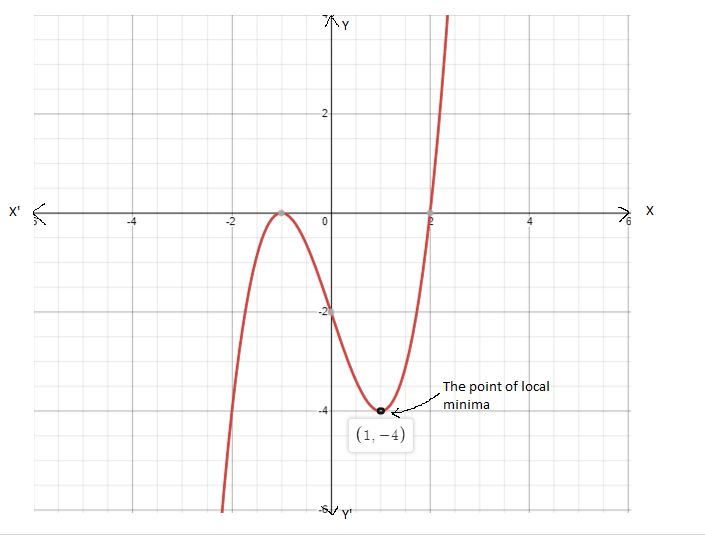
In the above graph, the local minimum is the point x=1.
The graph of the function f(x)=x3−3x−2 is as follows:
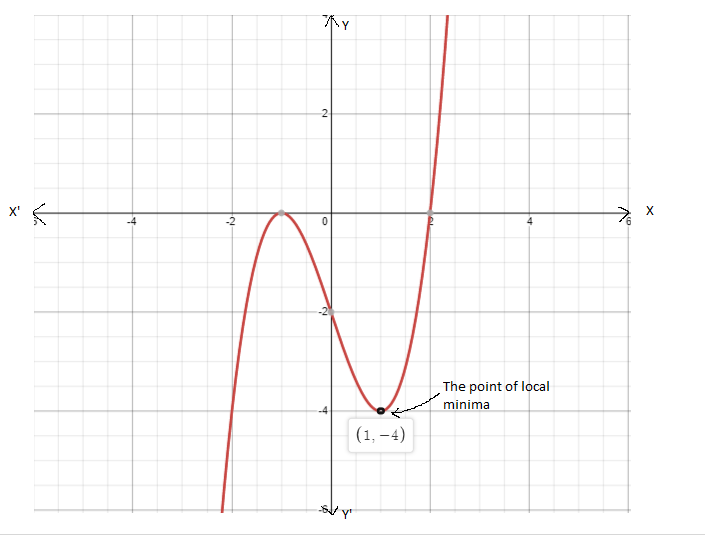
In the above graph x=1 is a point of local minimum.
Carnegie Learning Algebra II Chapter 3 Exercise 3.1 solutions
Carnegie Learning Algebra II Student Skills Practice 1st Edition Chapter 3 Exercise 3.1 Skills Practice Page 317 Problem 2 Answer
It is asked to provide an example for relative minima. Also, it is asked to graph a function that has relative minima.
Consider the function f(x)=x3−3x−2
Now, differentiate the function two times with respect to x.
f′(x)=3x2−3 and f′′(x)=6x
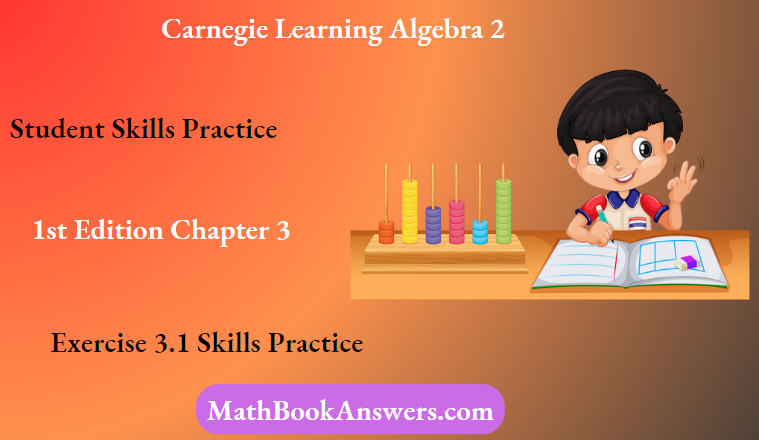
Now, for local maxima f′(x)=0.
3x2−3=0
x2−1=0
x2=1
x=±1
Now, for x=−1, f′′(x)=−6<0.
So, the point x=−1 is a local maximum.
The graph of the function f(x)=x3−3x−2 is as follows:
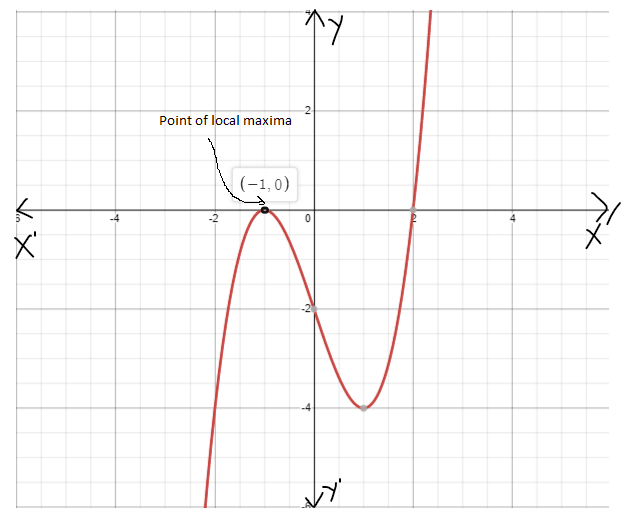
In the above graph the point x=−1 is a point of local maxima.
The graph of the function f(x)=x3−3x−2 is as follows:
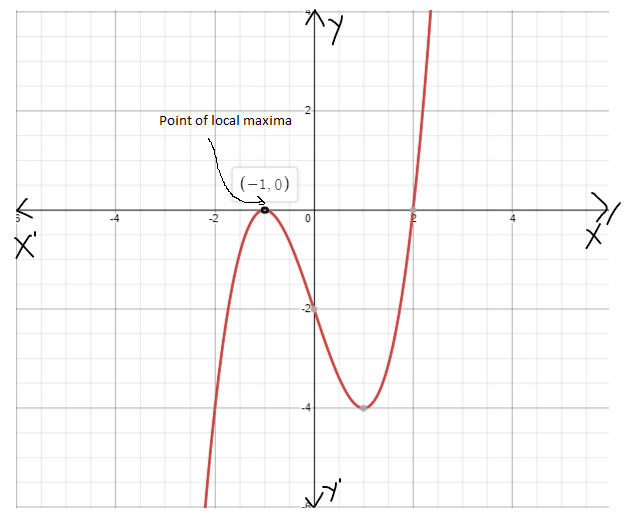
In the above graph x=−1 is a point of local maxima.
Page 317 Problem 3 Answer
In the above graph x=−1 is a point of local maxima.
Consider a function f(x)=x3+5x2+6x−7.
Observe that the highest power of x is 3.
So, the degree of the polynomial function is 3 .
So, this is a cubic function.
The graph of the function f(x)=x3+5×2+6x−7is as follows:
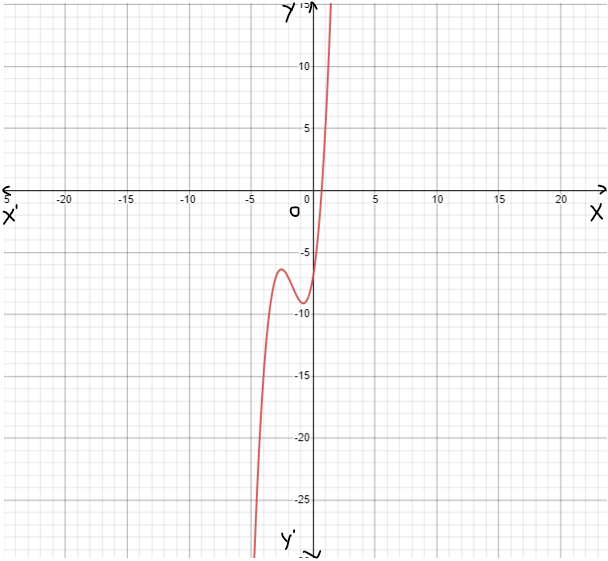
The above graph is drawn by taking X′OX as x−axis and Y′OY as y−axis.
The function f(x)=x3+5x2+6x−7 is a cubic function and the graph of his function is as follows:
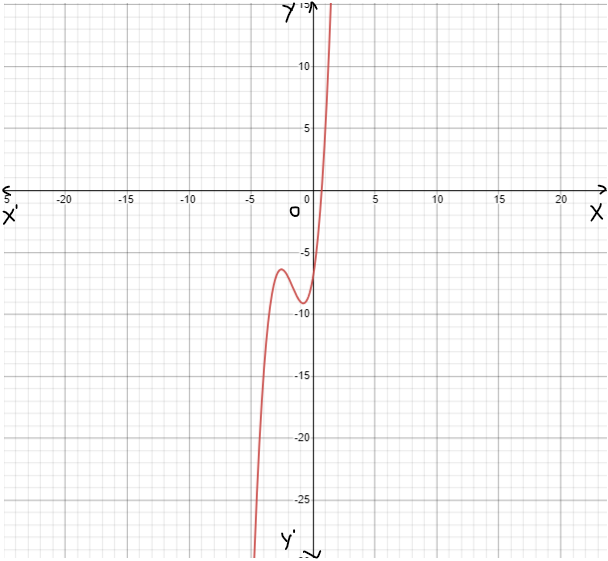
Page 317 Problem 4 Answer
It is asked to provide an example of a function that has roots with multiplicity or repeated roots.
Also, it is asked to give the graph of the function of the repeated roots.
Multiplicity means the number of repetitions of a root of an equation.
Consider a function f(x)=x(x−4)2(x−2)3.
To find the roots of the polynomial f(x) set f(x)=0.
x(x−4)2(x−2)3=0
This gives either x=0 or (x−4)2=0 or (x−2)3=0.
Now, when (x−4)2=0, then the function f(x) has a root x=4 of multiplicity 2.
Now, when (x−2)3=0, then the function f(x) has a root x=2 of multiplicity 3.
Also, the function f(x) has a root x=0 of multiplicity 1.
The graph of the function f(x)=x(x−4)2(x−2)3 is as follows:

The above graph is drawn by taking X′ OX as x−axis and Y′OY as the y−axis.
The function f(x)=x(x−4)2(x−2)3 has the roots x=4 of multiplicity 2 and the root x=2 of multiplicity 3
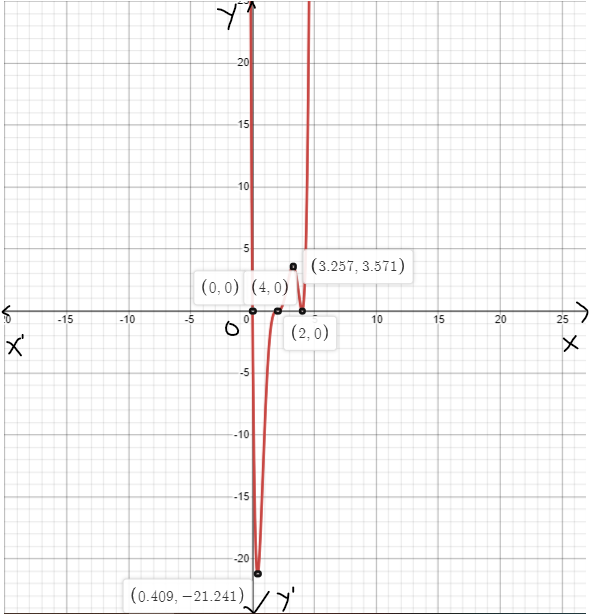
Skills Practice Carnegie Learning Algebra II Exercise 3.1 answers
Carnegie Learning Algebra II Student Skills Practice 1st Edition Chapter 3 Exercise 3.1 Skills Practice Page 317 Problem 5 Answer
Given is a table with Length width, height and volume.
Expressions given are formula to find the corresponding value of Length, Width and VolumeUse the expressions and find the value to complete the table And then circle the Relative maximum or minimum value A relative maximum point is a point where the function changes direction from increasing to decreasing.
Similarly, a relative minimum point is a point where the function changes direction from decreasing to increasing.
The table of Length, Width, Height and Volume of box:
| Height of the box(in) | Width of the Box(in) | Length of the Box(in) | Volume of Box |
| 0 | 8-2(0)=8 | 10-2(0)=10 | (0)(8)(10)=0 |
| 1 | 8-2(1)=8-2=6 | 10-2(1)=10-2=8 | (1)(6)(8)=48 |
| 1.5 | 8-2(1.5)=8-3=5 | 10-2(1.5)=10-3=7 | 1.5(5)(7)=52.5 |
| 2 | 8-2(2)=8-4=4 | 10-2(2)=10-4=6 | (3)(2)(4)=24 |
| 3 | 8-2(3)=8-6=2 | 10-2(3)=10-6=4 | (2)(4)(6)=48 |
| 4 | 8-2(4)=8-8=0 | 10-2(4)=10-8=2 | (0)(4)(2)=0 |
| h | 8-2h | 10-2h | h(8-2h)(10-2h) |
The complete table
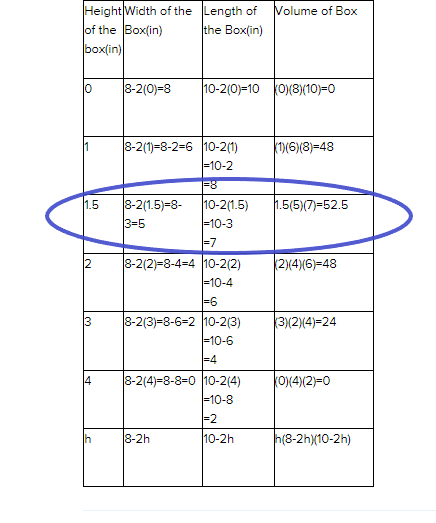
Page 318 Problem 6 Answer
Given is a Table with Radius ,height, Base Area and Volume of the cylinder.
To complete the Table, Find height, base area and volume of cylinder Use the formula given and find for each radius given in table And then Circle the Relative Maximum or minimum value
The Table of Radius, Height, Base Area and Volume of the cylinder:
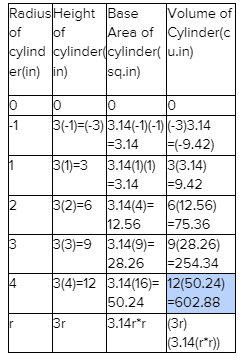
The Expression for Volume of Cylinder:(3r)(3.14r2)
The Complete table and Relative minimum

Carnegie Learning Algebra II Student Skills Practice 1st Edition Chapter 3 Exercise 3.1 Skills Practice Page 318 Problem 7 Answer
Given is a height of cube in which height, length and width is sameTo complete the table, find volume of the cube which is product of Length, width and height.
Then find Relative maximum or minimum and circle that value.
The table of Length, height, Width and volume of the cube:

The Expression for volume of cube is s 3
The Complete table
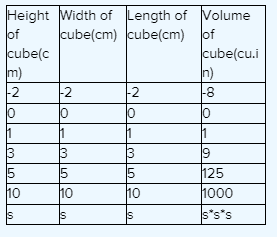
Page 318 Problem 8 Answer
Given is a table with Length width, height and volume.
Expressions given are formula to find the corresponding value of Length and WidthUse the expressions and find the value to complete the table And then circle the Relative maximum or minimum value A relative maximum point is a point where the function changes direction from increasing to decreasing.
Similarly, a relative minimum point is a point where the function changes direction from decreasing to increasing.
The table of Length, width, height and volume of Tank:
Height of Tank(m)
Width of tank(m)
Length of tank(m)
Volume of
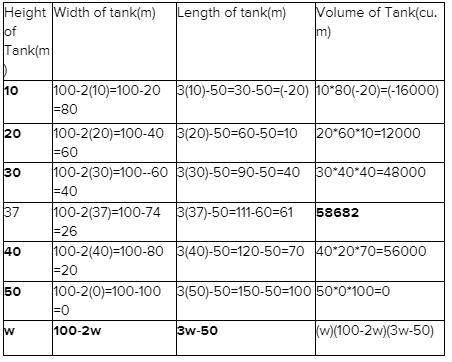
The Expression for Volume of Tank:V=w(100−2w)(3w−50)
The Relative maximum is at volume 58682
The complete table

Page 319 Problem 9 Answer
Given is the Height of Square Pyramid, using given expressions find Side of base length for each height value
Then Use expression given for Area of base to find for each height given
To find volume of Square Pyramid, use the formulaThen Circle the relative Maximum or minimum value.
The Table of Height, Side of base length, Area of base and Volume of Square Pyramid:
Height of Square Pyramid(tt)
Side
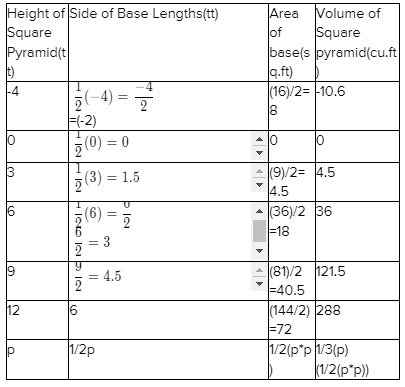
The Complete table
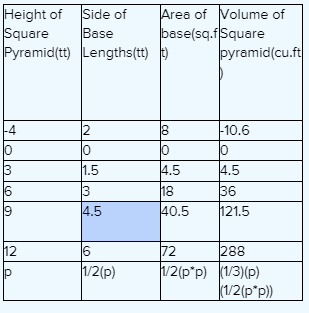
Page 319 Problem 10 Answer
The given table is

To do: Complete the given table.
The formula of volume of a triangular prism is
V=1/2×b×h×l
Where, b is the base, h is the height and l is the length of the triangular prism.
For the prism having length of the base, b=−0.5
Let, h=−2
And, l=−5
V=1/2×(−0.5)×(−2)×(−5)
V=−2.5 cu.dm
For the prism having the length of base, b=0
Let h=0
And, l=−5
Volume, V=1/2×0×0×(−5)
V=0 cu.dm
For the prism having the length of the base, b=0.3
Let, h=−0.4
And, l=2
Volume, V=1/2×0.3×(−0.4)×2
V=−0.12 cu.dm
For the prism having length of the base, b=0.5
Let, h=1
And, l=2
Volume, V=1/2×0.5×1×2
V=0.5 cu.dm
For the volume of the triangular prism, V=5cu.dm
Let, b=1
And, h=2
Now, by using the formula of volume of a triangular prism,
5=1/2×1×2×l
⇒l=5
For the prism having the height of the base, h=4
And, the length of the base, b=2
Let, l=8
V=1/2×2×4×8
V=32cudm
For the prism having the length of the base, b and length of the triangular prism, l=10 b−5.
Let, h=2b
V=1/2×b×2b×(10b−5)
V=b2(10b−5)
Now, complete the given table

Now, circle the relative maximum and relative minimum in the above table

The completed table with circles of relative minimum and maximum is shown below.

Page 320 Problem 11 Answer
Given is a three factors 2x−1 ,2x+1 and x+4 Multiply the three factors to find product
Then Assume random value for x and draw the graph for given factorsAnd then use same random value of x and draw the graph
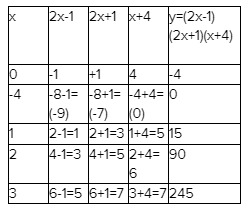
The Product:
(2x−1)(2x+1)(x+4)=(2x(2x)+2x(1)−1(2x)−1(1))(x+4)
(2x−1)(2x+1)(x+4)=(4x2+2x−2x−1)(x+4)
(2x−1)(2x+1)(x+4)=(4x2−1)(x+4)
(2x−1)(2x+1)(x+4)=(4x2(x)+4x2
(4)−1(x)−1(4))
(2x−1)(2x+1)(x+4)=4x3+16x2−x−4
The Table for graph of factors
The Graph of three factors
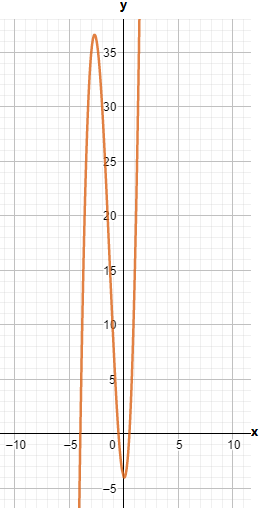
The Graph of Final Expression is
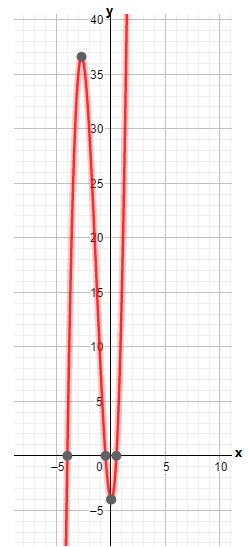
The product of three factors(2x−1)(2x+1)(x+4) are4x3+16x2−x−4.And The graph of two expressions are same so they are Equivalent.
Carnegie Learning Algebra II practice questions Chapter 3 Exercise 3.1
Page 320 Problem 12 Answer
Given is a three factors 4x−7 Multiply the three factors to find product
Then Assume random value for x to find y and draw the graph for given factors And then use same random value of x and draw the graph he product:
(4x−7)(4x−7)(4x−7)=(4x(4x)+4x(−7)−7(4x)−7(−7))(4x−7)
(4x−7)(4x−7)(4x−7)=(16x2−28x−28x+49)(4x−7)
(4x−7)(4x−7)(4x−7)=(16x2−56x+49)(4x−7)
(4x−7)(4x−7)(4x−7)=16x2
(4x)−56x(4x)+49(4x)+16x2(−7)−56x(−7)+49(−7)
(4x−7)(4x−7)(4x−7)=64x3−224x2+196x−112x2+392x−343
(4x−7)(4x−7)(4x−7)=64x3−336x2+588x−343
The table for final Expression
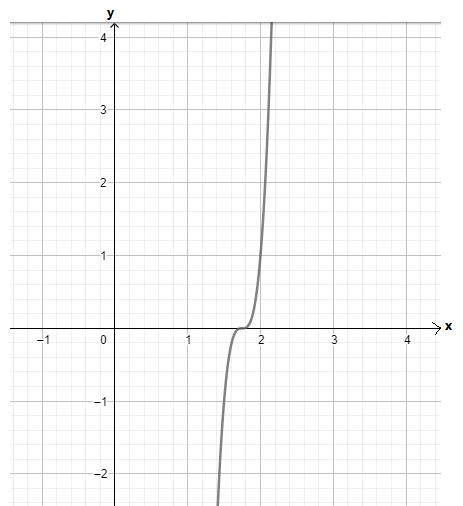
The Table of three factors
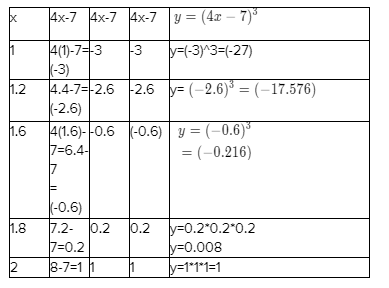
To draw a graph, Mark the points from tablesThe graph for three factors
The graph of the final expression
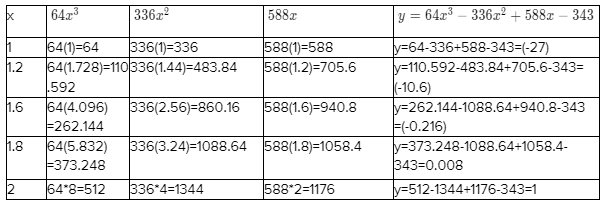
The product of three factors(4x−7)3 are 64x3−336x2+588x−343.
The graph of two expressions are same so they are Equivalent and it is shown below
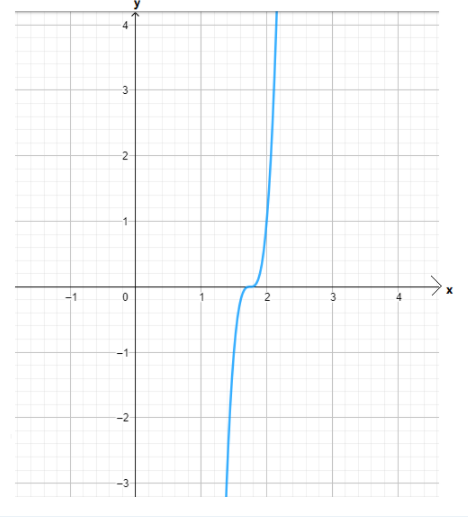

Carnegie Learning Algebra II Student Skills Practice 1st Edition Chapter 3 Exercise 3.1 Skills Practice Page 320 Problem 13 Answer
It is given the three factors10−3x ,7+x and 8+6x
It is asked to multiply the three factors to find their product.
Also, it is asked to find the graph to verify whether the product is right or wrong.
The given linear factors are (10−3x), (7+x) and (8+6x).
Consider the factors in the following fashion.
(10−3x)(7+x)(8+6x)
When the factors are in this fashion then the graph of the function is as follows:
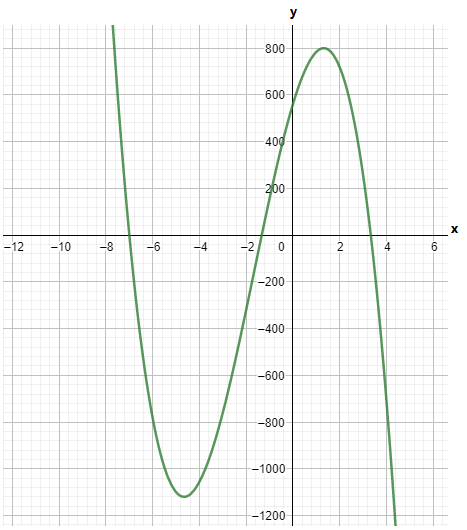
Now, multiply the linear factors as follows:
(10−3x)(7+x)(8+6x)
={10(7+x)−3x(7+x)}(8+6x)
={70+10x−21x−3x2}(8+6x)
={70−11x−3x2}(8+6x)
=70(8+6x)−11x(8+6x)−3x2(8+6x)
=560+420x−88x−66x2−24x2−18x3
=560+332x−90x2−18x3
Now, the graph of the product function will be as follows:
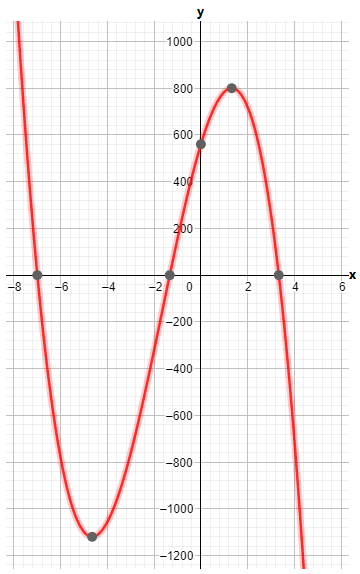
The product of three linear factors (10−3x)(7+x)(8+6x) is 560+332x−90x2−18x3.
The two graphs it verifies that the two graphs are the same. So, the linear product is equivalent.
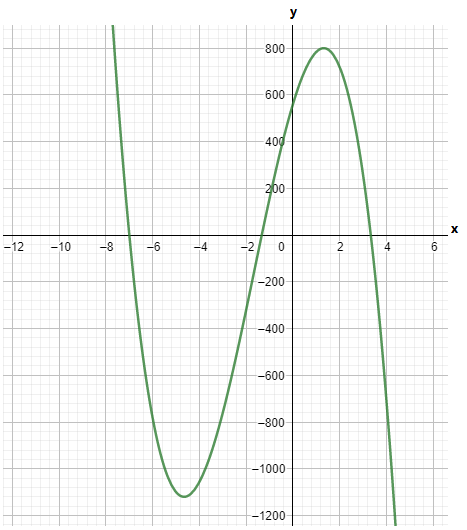
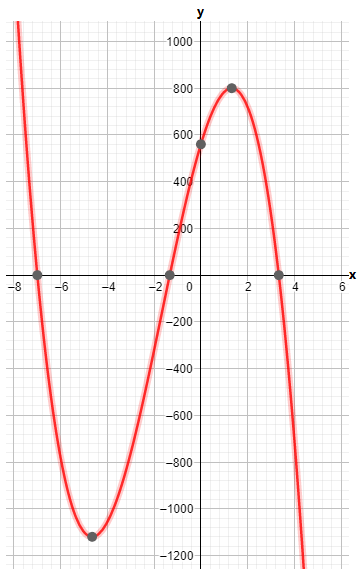
Page 321 Problem 14 Answer
It is given the linear factors (x/2),(2x/3),(x/4−1).
It is asked to find the product of the linear factors.
Also, it is asked to verify by drawing the graph whether the product and the linear factors are equivalent or not.
The given linear factors are (x/2),(2x/3),(x/4−1).
Write the linear factors in the following fashion:
f(x)=(x/2)(2x/3)(x/4−1)
Then the graph of the function f(x)=(x/2)(2x/3)(x/4−1) is as follows:

Now, multiply the given linear factors as follows:
f(x)=(x/2)(2x/3)(x/4−1)
=2x2/6(x/4−1)
=2x3/24−2x2/6
=x3/12−x2/3
Now, the graph of the function f(x)=x3/12−x2/3 is as follows:
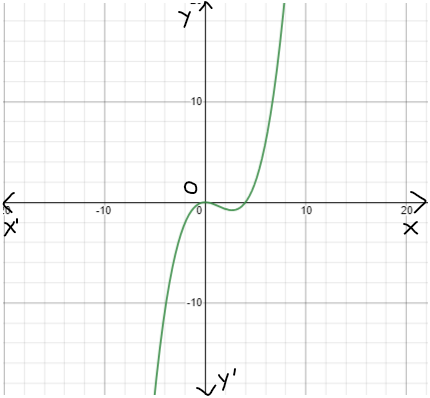
The graph of the function f(x)=(x/2)(2x/3)(x/4−1) is as follows:
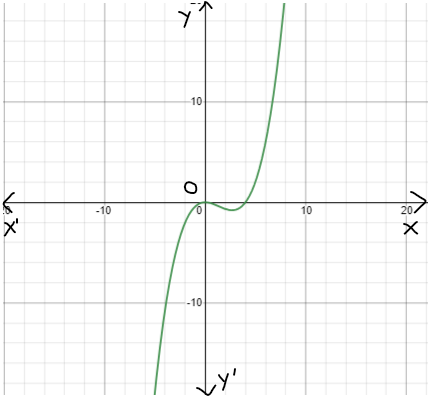
The graph of the function f(x)=x3/12−x23 is as follows:

The above two graphs show that that the product of the linear factors is equivalent to the expression x3/12−x2/3.
Chapter 3 Exercise 3.1 Carnegie Learning Algebra II key
Page 321 Problem 15 Answer
It is given the linear factors 0.25x,(12x−1),(8−3x). It is asked to find the product of the linear factors.
Also, it is asked to verify by drawing the graph whether the product and the linear factors are equivalent or not.
The given linear factors are 0.25x,(12x−1),(8−3x).
Write the linear factor in the following fashion: f(x)=0.25x(12x−1)(8−3x).
The graph of the function f(x) is as follows:

Now, product the linear factors as follows:
f(x)=0.25x(12x−1)(8−3x)
=0.25x{12x(8−3x)−(8−3x)}
=0.25x(96x−36x2−8+3x)
=0.25x(99x−36x2−8)
=24.75x2−9x3−2x
Now, the graph of the function f(x)=24.75x2−9x3−2x is as follows:
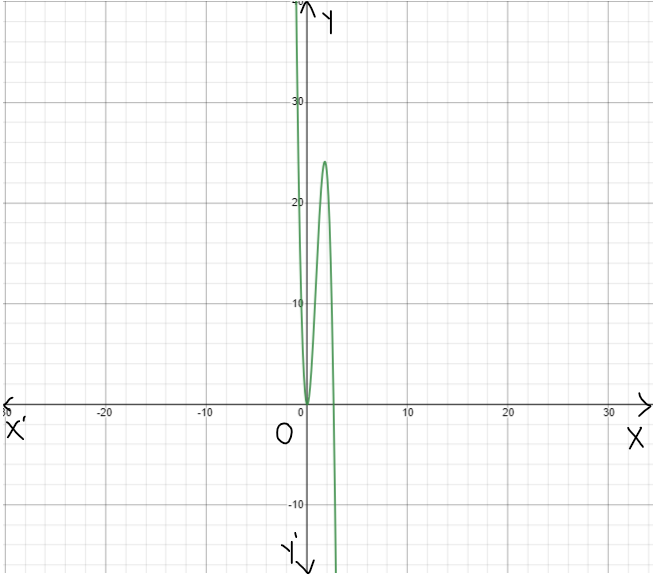
The graph of the function f(x)=0.25x(12x−1)(8−3x) is as follows:
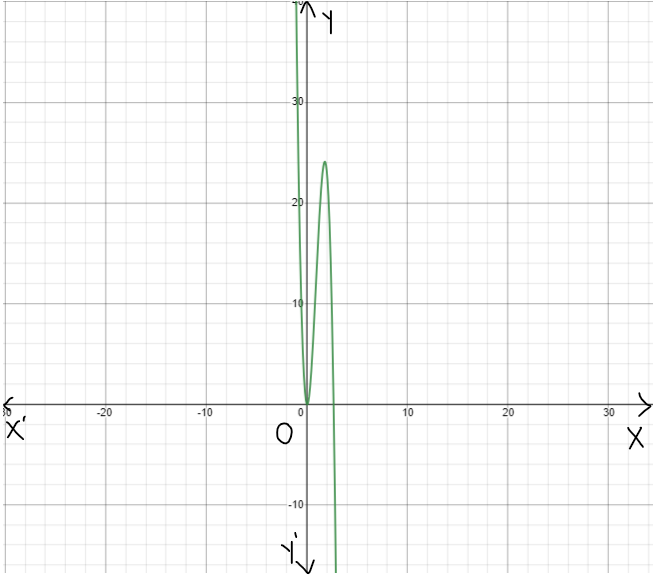
Also the graph of the function f(x)=24.75x2−9x3−2x is as follows:
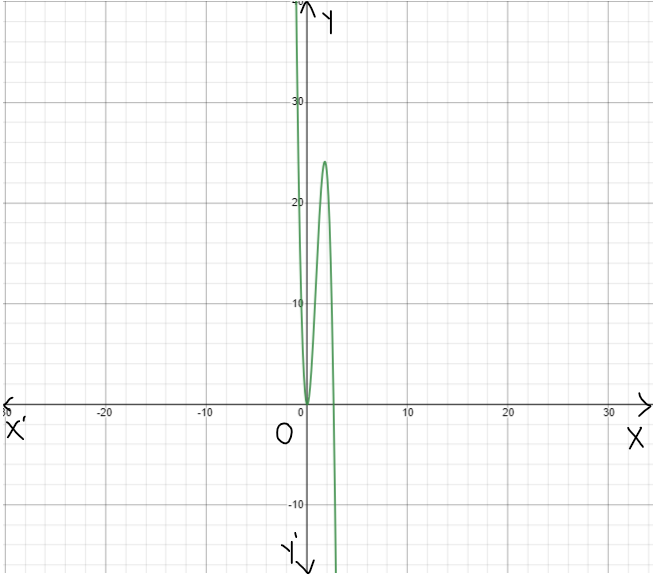
So, the above two graphs, it verifies that 0.25x(12x−1)(8−3x)=24.75x2−9x3−2x.
Carnegie Learning Algebra II Student Skills Practice 1st Edition Chapter 3 Exercise 3.1 Skills Practice Page 321 Problem 16 Answer
It is given the algebraic expression x(x2+3x−4). It is asked to find the product of the linear factor x
with the quadratic factor(x2+3x−4). Also, it is asked to verify by the graph whether the expression x(x2+3x−4) is equivalent to the product.
The given linear factor is x and the quadratic factor is (x2+3x−4).
Now, write the product of these in the following fashion:
x(x2+3x−4)
Now, the graph of the expression x(x2+3x−4) is as follows:
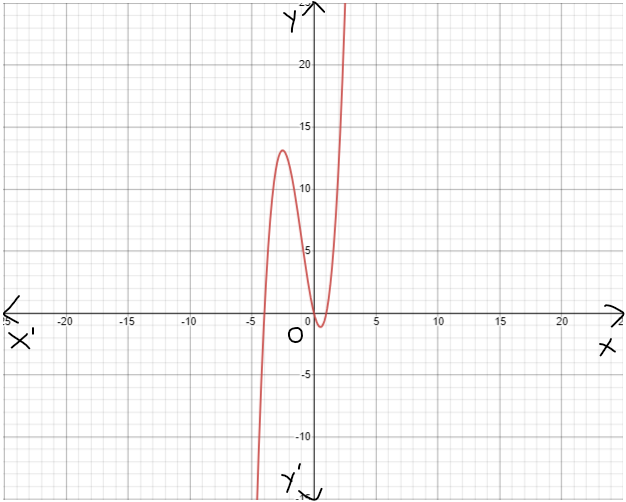
Now, multiply the expression f(x)=x(x2+3x−4) as follows:
f(x)=x(x2+3x−4)
=x3+3x2−4x
Now, the graph of the function f(x)=x3+3x2−4x is as follows:
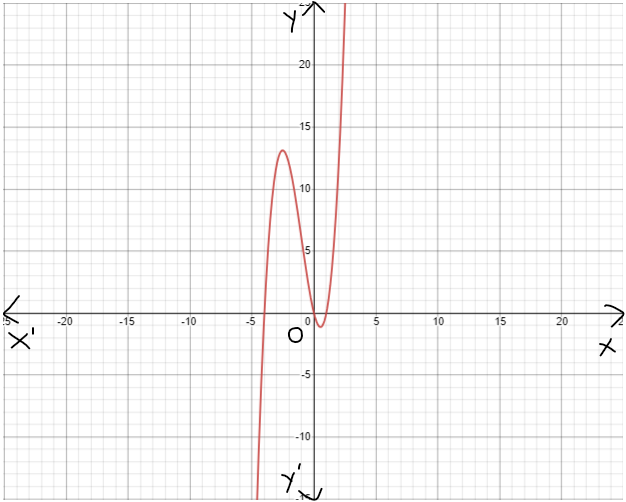
The graph of the expression f(x)=x(x2+3x−4)
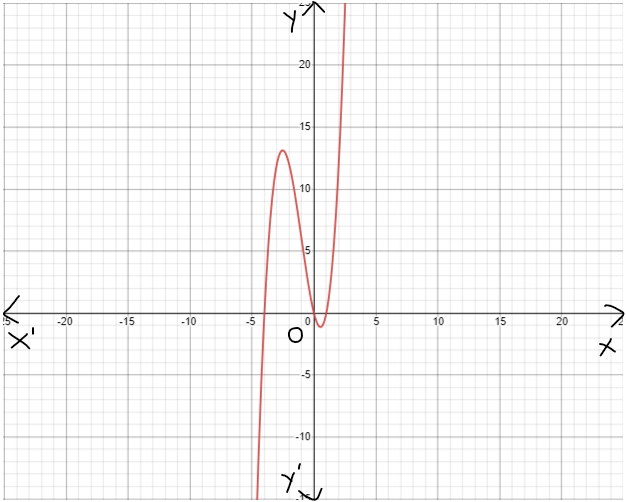
The graph of the expression f(x)=x3+3x2−4x is as follows:
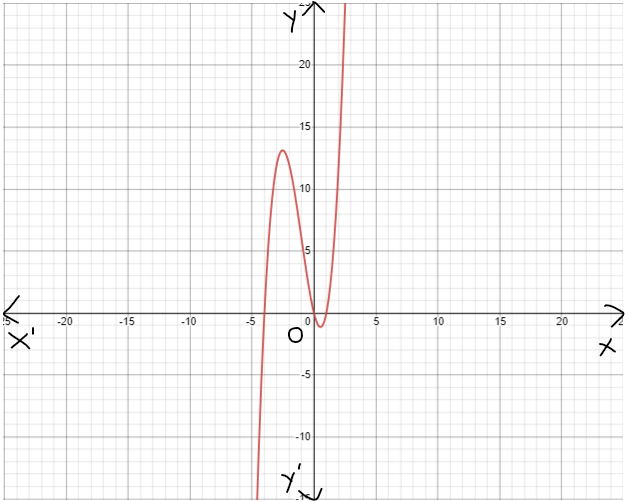
The above two graphs verify that the expression x(x2+3x−4) is equivalent to x3+3x2−4x.
Page 321 Problem 17 Answer
It is given the linear factor (2x−9) and the quadratic factor (4x2−5x−12).
It is asked to find the product of the linear and quadratic factors.
Also, it is asked to verify by the graph that expression (2x−9)(4x2−5x−12) is equivalent to resultant expression.
Consider that f(x)=(2x−9)(4x2−5x−12).
Now, the graph of the function f(x)=(2x−9)(4x2−5x−12) is as follows:

Now, find the product f(x)=(2x−9)(4x2−5x−12).
f(x)=(2x−9)(4x2−5x−12)
=2x(4x2−5x−12)−9(4x2−5x−12)
[By using the Distributive Property]
=8x3−10x2−24x−36x2+45x+108
=8x3−46x2+21x+108
Now, the graph of the expression f(x)=8x3−46x2+21x+108 is as follows:
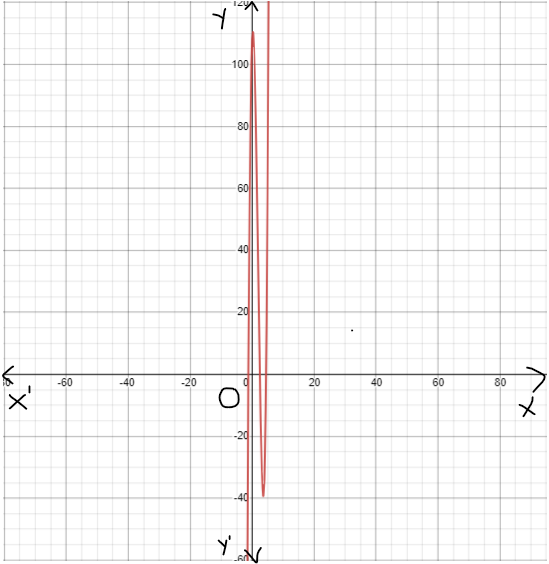
The graph of the expression f(x)=(2x−9)(4x2−5x−12) is as follows:
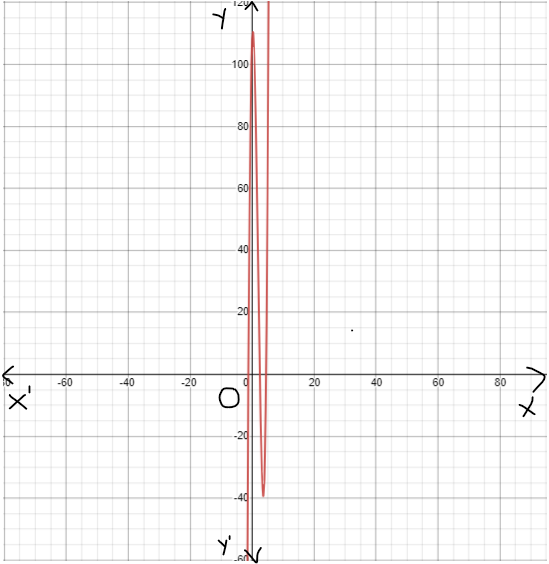
The graph of the function f(x)=8x3−46x2+21x+108 is as follows:

The above two graphs verify that (2x−9)(4x2−5x−12)=8x3−46x2+21x+108.
Carnegie Learning Algebra II Student Skills Practice 1st Edition Chapter 3 Exercise 3.1 Skills Practice Page 322 Problem 18 Answer
It is given linear factor 7x and a quadratic factor (x+5)2.
It is asked to find the product of the linear and quadratic factors.
Also, it is asked to explain whether the expression 7x(x+5)2 is equivalent to the resultant expression after multiplication.
Consider that f(x)=7x(x+5)2.
Now, the graph of the function f(x)=7x(x+5)2 is as follows
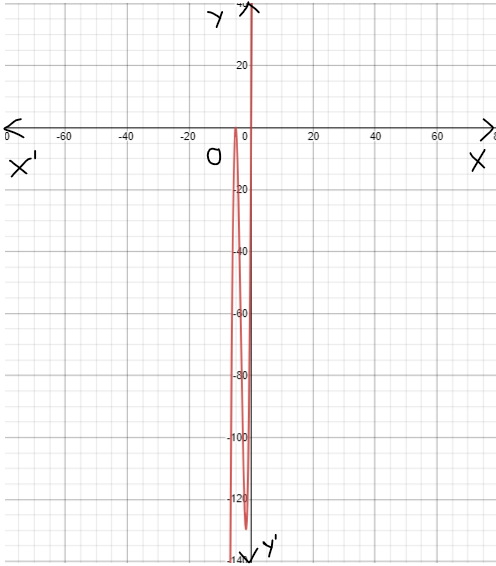
Now, find the product of the expression f(x)=7x(x+5)2.
f(x)=7x(x+5)2
=7x(x2+10x+25)
=7x3+70x2+175x
[By using the Distributive Property]
Now, the graph of the expression f(x)=7x3+70x2+175x is as follows:
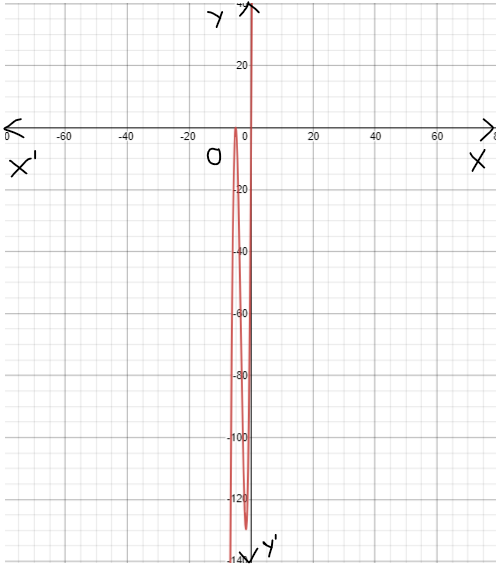
The graph of the function f(x)=7x(x+5)2 is as follows:
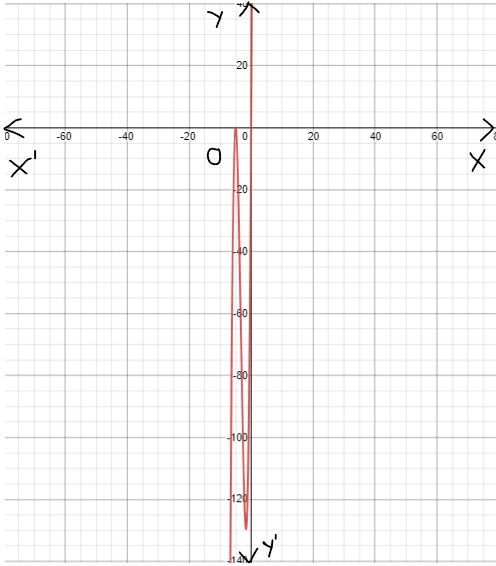
The graph of the expression f(x)=7x3+70x2+175x
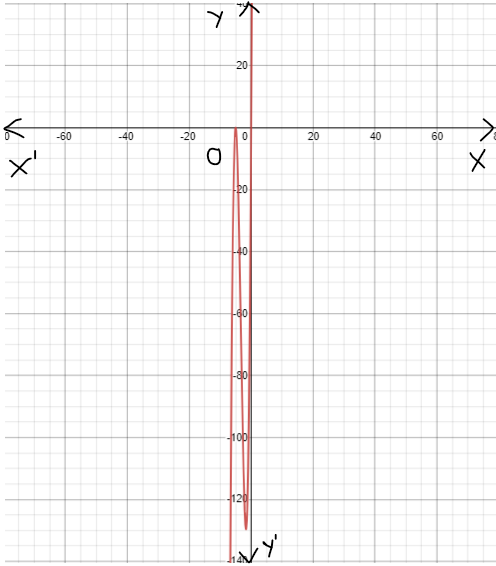
The above two graphs verify that 7x(x+5)2=7x3+70x2+175x.
How to solve Chapter 3 Exercise 3.1 Algebra II Carnegie Learning
Carnegie Learning Algebra II Student Skills Practice 1st Edition Chapter 3 Exercise 3.1 Skills Practice Page 322 Problem 19 Answer
It is given the quadratic factor (x2+1) and linear factor (8−x).
It is asked to find the product of the quadratic factor and linear factor.
Also, it is asked to verify by the graph that the expression(x2+1)(8−x) is equivalent to the resultant expression of the product.
Consider the expression f(x)=(x2+1)(8−x).
The graph of the function f(x)=(x2+1)(8−x) is as follows:

Now, find the product of the factors of the function f(x)=(x2+1)(8−x).
f(x)=(x2+1)(8−x)
=x2(8−x)+(8−x)
=8x2−x3+8−x
Now, the graph of the function f(x)=8x2−x3+8−x is as follows:
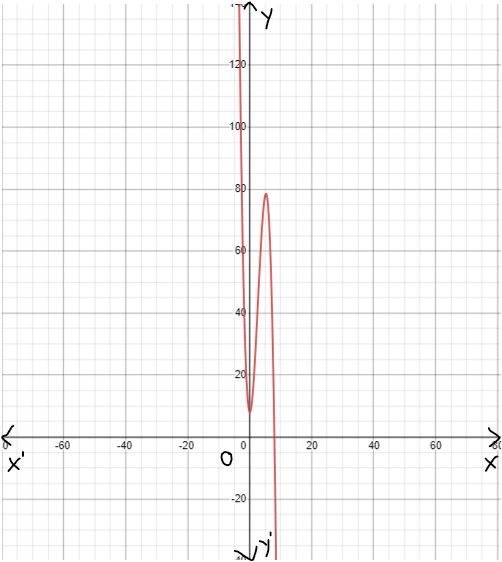
The graph of the function f(x)=(x2+1)(8−x) is as follows:

The graph of the function f(x)=8x2−x3+8−x is as follows:

The above two graphs verify that (x2+1)(8−x)=8x2−x3+8−x.
Page 322 Problem 20 Answer
It is given the quadratic factor (−2.3+1.1x+0.9x2) and the linear factor (4.5x−3.8).
It is asked to find the product of the linear and quadratic factors.
Also, it is asked to verify by the graph that the expression (−2.3+1.1x+0.9x2)(4.5x−3.8) is equivalent to the resultant expression after multiplication.
Consider that f(x)=(−2.3+1.1x+0.9x2)(4.5x−3.8).
Now, the graph of the function f(x)=(−2.3+1.1x+0.9x2)(4.5x−3.8) is as follows:
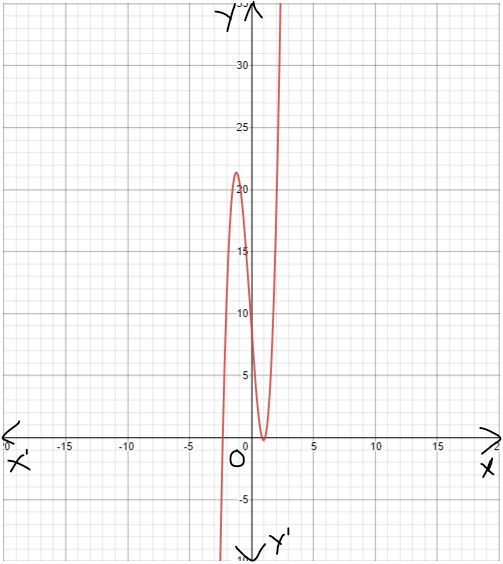
Now, multiply the function f(x)=(−2.3+1.1x+0.9x2)(4.5x−3.8).
f(x)=(−2.3+1.1x+0.9x2)(4.5x−3.8)
=(−2.3+1.1x+0.9x2)(4.5x)−(−2.3+1.1x+0.9x2)3.8
=−10.35x+4.95x2+4.05x3+8.74−4.18x−3.42x2
=4.05x3+1.53x2−14.53x+8.74
Now, the graph of the function f(x)=4.05x3+1.53x2−14.53x+8.74 is as follows:

The graph of the function f(x)=(−2.3+1.1x+0.9x2)(4.5x−3.8) is as follows:

The graph of the function f(x)=4.05x3+1.53x2−14.53x+8.74 is as follows:

The above two graphs verify that (−2.3+1.1x+0.9x2)(4.5x−3.8)=4.05x3+1.53x2−14.53x+8.74.
Chapter 3 Carnegie Learning Algebra II Exercise 3.1 worked examples
Page 322 Problem 21 Answer
It is given the quadratic factor (−3/4x2+1/8) and the linear factor (1/4−7x/8).
It is asked to find the multiplication of the linear and quadratic factors.
Also, it is asked to verify by the graph that the expression (−3/4x2+1/8)(1/4−7x/8) is equivalent to the resultant product.
Consider the function f(x)=(−3/4x2+1/8)(1/4−7x/8) .
Now, the graph of the function f(x)=(−3/4x2+1/8)(1/4−7x/8 is as follows:
Now, multiply the factors in the function f(x)=(−3/4x2+1/8)(1/4−7x/8).
f(x)=(−3/4x2+1/8)(1/4−7x/8)
=−3/4x2(1/4−7x/8)+1/8(1/4−7x/8)
=−3/16x2+21x3/32+1/32−7x/64
Now, the graph of the function f(x)=−3/16x2+21x3/32+1/32−7x/64 is as follows:

The graph of the function f(x)=(−3/4x2+1/8)(1/4−7x/8) is as follows:

The graph of the function f(x)=−3/16x2+21x3/32+1/32−7x/64 is as follows:
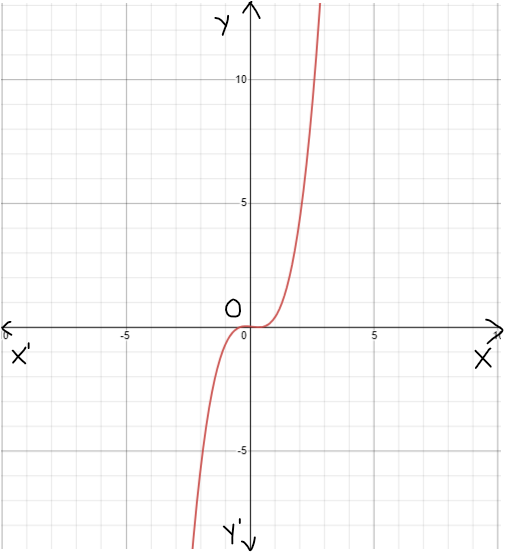

The above two graphs verify that (−3/4x2+1/8)(1/4−7x/8)=−3/16x2+21x3/32+1/32−7x/64.
